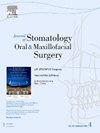从骨骼单位的角度看颅面微畸形儿童牵引成骨术后的下颌骨生长。
IF 1.8
3区 医学
Q2 DENTISTRY, ORAL SURGERY & MEDICINE
Journal of Stomatology Oral and Maxillofacial Surgery
Pub Date : 2024-11-05
DOI:10.1016/j.jormas.2024.102136
引用次数: 0
摘要
背景:颅面显微畸形(CFM)患者牵张成骨(DO)后的下颌骨生长情况仍不清楚。我们的目的是根据骨骼单位研究牵张成骨术对普鲁赞斯基-卡班 IIA 型 CFM 患儿下颌骨生长的短期和长期影响:我们收集了15名CFM患儿术前(T0)、移除牵引器后(T1)和移除牵引器后4-6年(T2)的计算机断层扫描数据。测量结果用于评估骨骼单位的大小和方向。对线性和角度测量进行分析,以评估DO的短期和长期影响。评估了T1和T2期间每个单元的双侧生长率(GRs)差异:结果:术前,患侧的髁突和体单位比未受影响的一侧小。从 T0 到 T1,患侧的体单位显著增加,骨骼单位方向趋于正常。然而,从 T1 到 T2,患侧单位的 GRs 明显慢于未受影响的一侧。虽然患侧的髁状突和体部单位长度没有出现统计学意义上的显著增加,但角度单位长度却有所减少。受影响一侧的单位排列也出现了复发:我们的研究结果表明,早期 DO 对 CFM 患儿的下颌骨生长有潜在的长期抑制作用。这个问题需要进一步关注,因为在 DO 之后促进骨骼单位生长的策略对于获得最佳的长期治疗效果至关重要。本文章由计算机程序翻译,如有差异,请以英文原文为准。
Mandibular growth following distraction osteogenesis in children with craniofacial microsomia from a skeletal units perspective
Background
Mandibular growth following distraction osteogenesis (DO) in patients with craniofacial microsomia (CFM) remains unclear. We aimed to investigate both the short- and long-term effects of DO on mandibular growth in children with Pruzansky–Kaban type IIA CFM based on skeletal units.
Materials and methods
We collected computed tomography data from 15 children with CFM preoperatively(T0), immediately after distractor removal(T1), and 4–6 years after distractor removal(T2). Measurements were taken to assess the size and orientation of the skeletal units. Linear and angular measurements were analyzed to evaluate the short- and long-term effects of DO. Bilateral differences in growth rates (GRs) for each unit between T1 and T2 were assessed.
Results
Preoperatively, the affected side exhibited smaller condylar and body units than the unaffected side. From T0 to T1, there was a significant increase in the body unit and normalization of the skeletal unit orientation on the affected side. However, from T1 to T2, the GRs of the units on the affected side were significantly slower than those on the unaffected side. Although the condylar and body unit length on the affected side did not show statistically significant increases, the angular unit length decreased. Relapses were also observed in the alignment of the units on the affected side.
Conclusions
Our findings suggest a potential long-term inhibitory effect of early DO on mandibular growth in children with CFM. This issue requires further attention as strategies to promote the growth of skeletal units following DO are critical for optimal long-term treatment outcomes.
求助全文
通过发布文献求助,成功后即可免费获取论文全文。
去求助
来源期刊

Journal of Stomatology Oral and Maxillofacial Surgery
Surgery, Dentistry, Oral Surgery and Medicine, Otorhinolaryngology and Facial Plastic Surgery
CiteScore
2.30
自引率
9.10%
发文量
0
审稿时长
23 days
 求助内容:
求助内容: 应助结果提醒方式:
应助结果提醒方式:


